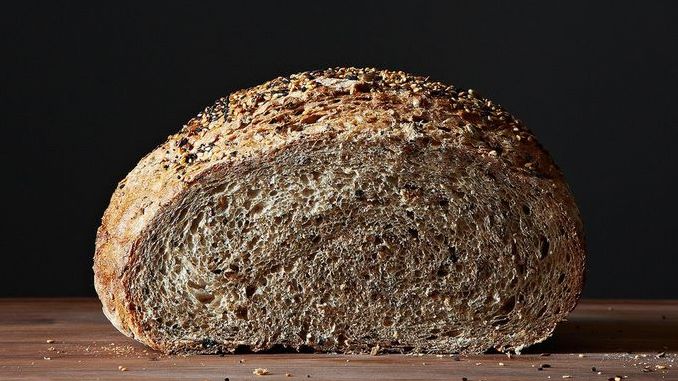The answer is no, you shouldn’t. Pro bakers will tell you that slicing bread straight from the oven is a no-no and that letting this cool down considerably is a must.
If you want this hot, the best thing to do is place a couple of slices in the toaster and reheat it.
Baking, if you aren’t aware yet, is a science.
All the precise measuring of the ingredients, just the right mixing of batters and kneading of doughs, and the exact temperatures for rising and actual baking prove the point above.
And science is backing this need for patience.
Basic Bread Anatomy
When you look at a cross-section of a baked loaf, you’ll see two distinct parts:
The crust is everything that’s outside. It’s the golden-brown exterior that, when squeezed, will give off that scrumptious crispy crackle.
The crumb is everything that’s inside.
This is supposed to be whiter or lighter in color than the crust and have a softer, airier texture.
Sourdoughs, ciabattas, and baguettes have lots of holes in the crumb.
Rolls and milky loaves look smoother with lesser holes and have a creamier mouthfeel.
The Science Behind the Right Prep
To be honest, this is one of the most tedious jobs because it involves several steps, each lasting at least an hour.
Missing one step or cutting back on the time provided will yield bad results.
Again, patience is required here.
• Mis En Place – gathering all ingredients, measuring everything accurately. Preparation of the poolish or any other starter is part of this step.
• Mixing according to the recipe
• Kneading as advised
• Bulk fermentation – the first rise of the dough
• Shaping
• Proofing – the second rise of the dough
The Science in Baking
Aside from the time given in the recipe, looking at and feeling your dough is a great way to know if it’s ready to be baked.
First, it should have risen to a good volume. Second, it bounces back when you press on it.
Some require dry heat while others need steam.
Some are baked on a plain metal sheet while others should be placed in a covered cast iron pan.
Whichever you’re getting, one important thing you should never forget is pre-heating the oven.
The heat is what sets off the various chemical reactions in the dough, cooking the crumb and coloring the crust.
The Science in Cooling Down
The cooking process does not end when you take the bread out of the oven.
The heat inside the baked good is still doing its magic – better known as starch retro-gradation.
What happens here is that the water molecules are moving from the crumb to the crust, causing aeration in the former and giving the latter that crisp as water transforms into steam through it.
You can hear this happening when you take it out of the heat and place it onto a cooling rack.
If you take a knife to it too soon, you’re letting those water molecules out fast resulting in a soggy loaf.
You’ll notice that, on your second slice, the knife will deform it.
On your third slice, it will feel gummy and hard to chew.
Aside from the consistency, the flavor is also allowed to mature during the post-baking resting time.
Sourdoughs, for example, tastes so much better when sliced a whole day after it was cooled down.
How Long Should the Wait Be?
This depends on what kind of bread you made. Here are some of the most common ones:
• Whole grain – 1 hour
• Rye – 1 hour
• Ciabatta – 30-45 minutes
• Brioche – 20-30 minutes
• Challah – 20-30 minutes
• Banana (or other fruity) bread – 20 minutes
• Irish soda bread – 5-10 minutes
• Sourdough – 2 hours (Resting this longer, even overnight, will allow it to develop more flavor)
• Baguette – 20 minutes, although some swear it’s alright to tear into this straight from the oven.
• Dinner rolls – 3 minutes
Want It Hot?
Re-heat!
Except for dinner rolls and (as some will insist) baguettes, you need to wait another hour before you can eat your loaf. That’s a fact.
If you want to eat hot bread, the type wherein butter will melt beautifully, the next best thing for you to do is to return it to the oven to heat just before you serve it.
Believe it or not, this is what Michelin-star restaurants do.
Don’t think that ‘fresh off the oven’ means tearing into bread literally after you’ve pulled it out of the heat.
Just be patient and you’ll get your just desserts (or impressively baked good).

